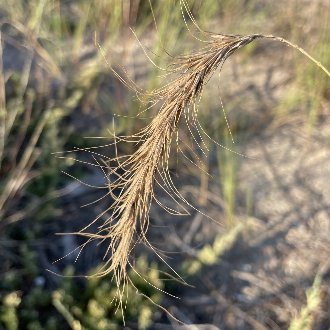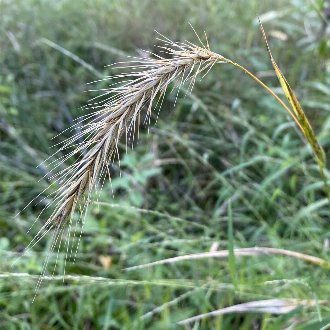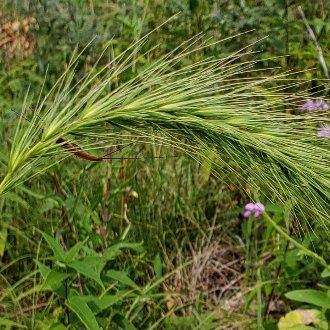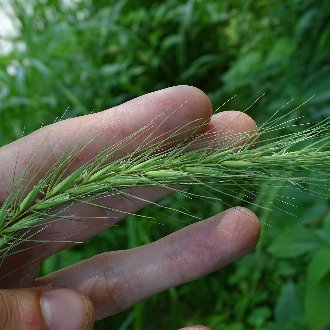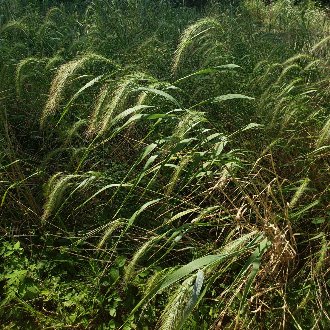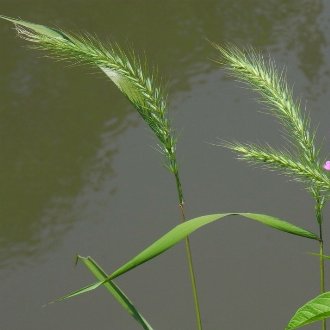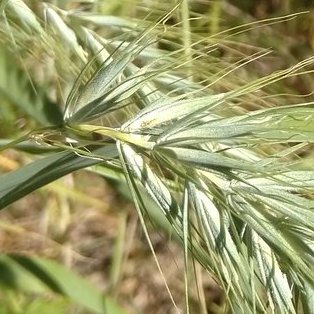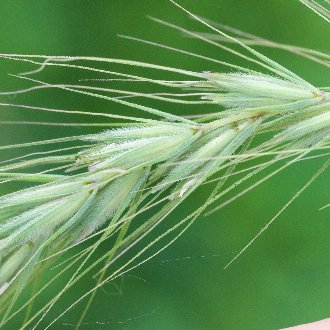Canada Wildrye vs Riverbank Wildrye
These two species are easily confused, especially early in the season before spikes dry out. Both can be glaucous and both have long, drooping spikes. They are readily distinguished by whether or not the awns curl later in the season. E. riparius is more restricted to moist, usually riparian habitats, tolerates greater shade, and ranges farther south in the east of its range. E. canadensis prefers sunnier and more disturbed habitats, can occur in drier habitats, and ranges much farther west.
Canada Wildrye (Elymus canadensis) | Riverbank Wildrye (Elymus riparius) |
A short-lived perennial, cool-season grass native primarily to the great plains, also extending well into the west and northeast. | A perennial, cool-season bunchgrass native mostly to northeastern North America, typically found in riparian areas. |
Awns on mature spikes curl back as they dry out. Photo © Matt Berger, CC BY 4.0. | Awns remain straight even as spikes dry out. Photo © Henry Frye, Public Domain. |
Spikes average wider (3-7cm), even when immature. Photo © aarongunnar, CC BY 4.0. | Spikes average narrower (2-4cm) Photo © Reuven Martin, Public Domain. |
Auricles, clasping outgrowths where the leaf blade meets the stem, are always present, averaging larger (1.5-4mm), and darker, brown to purplish-black. Photo © Cleveland Powell, CC BY 4.0. | Auricles may be absent, and when present, are smaller (0-2mm) and less conspicuous, averaging a lighter brown color. Photo © Zihao Wang, CC BY 4.0. |
Found in a range of moisture conditions, ranging into much drier habitats. Can be found in floodplains but usually absent from the lowest, wettest sites. Prefers sunnier, more disturbed habitats. Photo © Sharika Elahi, Public Domain. | Restricted to moist habitats, tolerating temporary flooding or waterlogged soils, often growing right to the water's edge. Photo © mjpapay, CC BY 4.0. |
Bodies of glumes (bracts at the bases of each spikelet) may be slightly wider (0.5-1.6mm) and are usually clearly differentiated from their awns. When they can be distinguished, glume bodies are shorter than the lowest lemma bodies they enclose. Photo © Marilynn Miller, CC BY 4.0. | Glume bodies are so narrow (0.5-0.8mm) that they are often undifferentiated from their awns. When they can be distinguished, glume bodies are longer than the lowest lemma bodies they enclose. Photo © Owen Strickland, Public Domain. |
References & External Resources
These short lists show only links helpful for ID. For a complete list of references and resources also covering other aspects of ecology, visit the links section of the full article on each plant, which is the first entry here.



